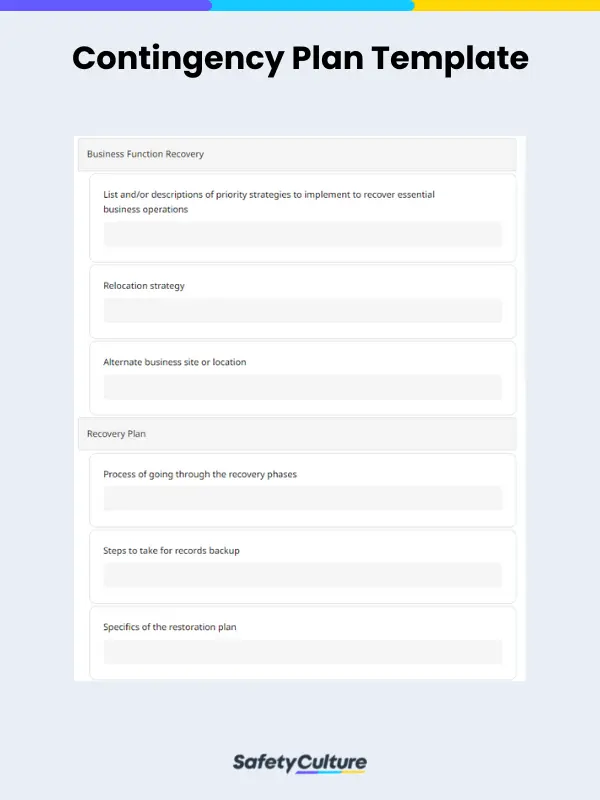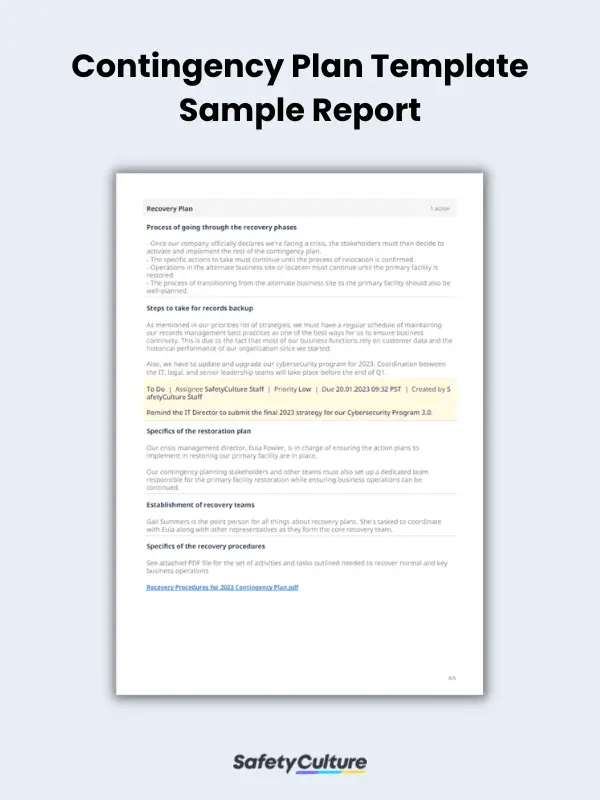What is a Contingency Plan Template?
A contingency plan is a plan of action put in place to help businesses, governments, and organizations prepare for and respond to an unexpected event or situation and ensure that operations can continue amidst an emergency or disruption. Hence, a contingency plan template is a tool used to replicate, streamline, and standardize the process of creating such plans depending on the type of situation.
Benefits of Using One
A contingency plan is designed to help an organization or individual anticipate and manage potential business risks and minimize the impact of an unexpected event. These plans may include strategies for responding to a natural disaster, a cyber attack, or a financial crisis. They may also include strategies for dealing with personnel issues, such as sudden resignation or illness.
Having a contingency plan in place can also help ensure that the business is prepared for and able to respond accordingly to any potential risks or threats. Thus, it can minimize the potential for costly delays or disruptions. Using a template when writing or creating it provides you with the following benefits and more:
- Ensure all key information is supplied: Having to create a plan from scratch can be tedious and presents the risk of forgetting important information. With a template, you can replicate the most basic details that the plan must include and then customize it accordingly.
- Organize and standardize the format of a contingency plan: To help an organization quickly respond to a crisis and ensure business continuity, team members should know where to look for the necessary information they need. This is where having such details in a template is deemed helpful.
- Make the process of creating plans easier: To let you save time and effort, you can use a contingency plan template that you can already work on instead of creating one from scratch.
Risks of Not Having a Contingency Plan
Without a contingency plan, businesses are at risk of facing serious consequences. The most obvious risk of not having a contingency plan is the potential for financial losses. Without a plan in place, businesses may not be able to recover from unexpected events, including natural disasters, power outages, or cyber-attacks. This could lead to significant financial losses and a decrease in customer confidence as the business fails to deliver the expected outcomes.
Another risk of not having a contingency plan is the potential for operational disruption. Businesses may not be able to respond quickly and effectively to unexpected events. This could lead to delays in operations, which could have a negative impact on customer service and satisfaction. Additionally, it could lead to a decrease in overall organizational productivity and efficiency, resulting in costly damages.
Types
There are several types of contingency plans that can be used to help an organization prepare for and respond to unexpected events. Some of the most common ones include the following:
Business Continuity
One type of contingency plan is a business continuity plan. This is designed to help an organization continue to operate in the event of a disruption, which uses a more general approach. The plan outlines the steps that need to be taken to ensure that the organization can continue to operate and provide services to its customers.
Disaster Recovery Plan
Another type of contingency plan is a disaster recovery plan. This type focuses more on the specific risks that disasters pose to the organization and how it can restore its processes and systems after an unplanned event or emergency.
Crisis Management
This type is where specific actions or steps are taken when an actual crisis occurs. Hence, a crisis management plan outlines the official protocols of an organization on how to respond to crises that put its operational capacity and employee safety at risk.
How to Use and What to Include in a Contingency Plan Template
Make sure your contingency plan template has the following sections and elements to ensure a comprehensive course of action:
- Title Page – The first page of your checklist or template must include the name of the business, its location, the date of creation of the contingency plan, its version history, and who prepared it.
- Business Function Recovery – This is where you should specify, describe, or list the actions and strategies that you’ll apply once your business functions need to be recovered in an alternate business site.
- Recovery Plan – This part outlines how your business will go through each of the recovery phases, what steps to take for your priority strategies, and the respective teams to be in charge of carrying out each phase and task in the contingency plan.
- Completion and Sign-off – Have the plan creator and approver sign the template before completing and exporting the report for proper documentation.
Lastly, it’s important to regularly review and update contingency plans to ensure that they are up to date and reflect the current needs of the organization. Aside from this, contingency plan templates must also be updated regularly to reflect the necessary changes and key components they should contain.
FAQs About Contingency Plans
For a contingency plan to work, it must have the most basic components at its core. This way, organizations can prepare one that’s clearly written, has specific action points, and outlines concrete steps that the stakeholders can take to ensure business continuity. The 4 components of a contingency plan are the following:
- Preparation
- Analysis
- Response Planning
- Implementation Preparedness
Triggers may vary depending on the organization and its industry. They can be due to a specific action or based on a general condition. In this sense, triggers refer to events or circumstances that prompt the need for you to use your organization’s contingency plan.
A project management contingency plan template refers to a tool used in creating an actionable plan that needs to be implemented when a project’s identified risk materializes. This is where a Plan B must be in place, which will serve as a safety net for the project team to effectively get back on track.




